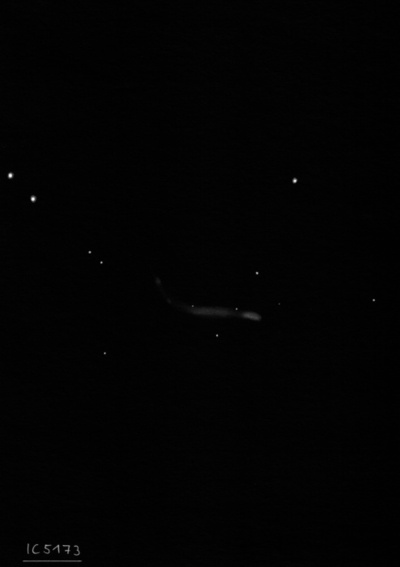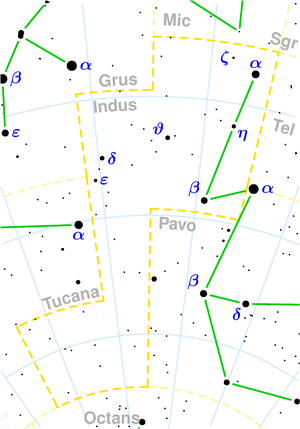 A small and faint constellation of the southern sky surrounded by a trio of feathered constellations: the Grus, the Tucana, the Pavo, and straying to near the south pole of the sky. It is probably difficult to imagine a North American Indian in the few obscure stars of this constellation. The slightly more conspicuous Pavo, whose brightest star, Pavo, lies in close proximity to the Indian, may serve as a guide to locating the constellation. This constellation is not visible here.
A small and faint constellation of the southern sky surrounded by a trio of feathered constellations: the Grus, the Tucana, the Pavo, and straying to near the south pole of the sky. It is probably difficult to imagine a North American Indian in the few obscure stars of this constellation. The slightly more conspicuous Pavo, whose brightest star, Pavo, lies in close proximity to the Indian, may serve as a guide to locating the constellation. This constellation is not visible here.
α Ind - The brightest star of the constellation has an apparent magnitude of 3.21. It is located 100 light years away.
θ Ind - relatively easily distinguishable double star for a small telescope. The primary component has a brightness of 4.7mag and its companion with a brightness of 7.1mag is located at a separation of 6 arcseconds. This system is located at a distance of 97 light years.
ε Ind - One of our closest stars, located just 11.3 light-years away. This yellow dwarf of fifth magnitude is somewhat similar to the Sun. Its diameter reaches 4/5 of the solar diameter and its luminosity is 1/8 of the Sun's luminosity. It is the least luminous star visible to the naked eye. It has a fast proper motion and moves 4.7" across the sky in a year. By the year 2640, it will be part of a different constellation - Tucana.
IC 5152
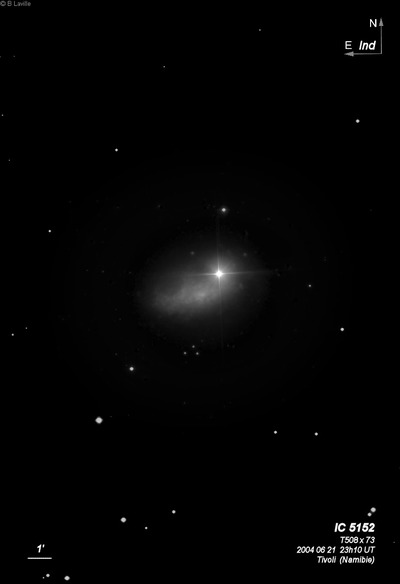
DeLisle Stewart discovered IC 5152 = DS 732 on a plate taken in 1899 at Harvard's Arequipa station in Peru. He noted "F, cL, cE at 150°, cbM." This galaxy is often listed as a Local Group member though is likely outside the Local Group.
200/250mm - 11" (8/8/04 - Haleakala Crater): at 127x appeared moderately bright, fairly large, elongated 2:1 ~E-W, roughly 2.5'x1.3', broad weak concentration to a slightly brighter core. A 7.7-magnitude star (HD 209142) is superimposed just north of the west end of the galaxy and somewhat hinders the view. With averted vision the glow appears to extend slightly west of the bright star and the core is just a small brightening to the east of the star.
400/500mm - 18" (7/6/02 - Magellan Observatory, Australia): this nearby Irregular galaxy (probably just outside the Local Group) was viewed at 171x and 228x. It appeared bright, large, elongated 2:1 ~WNW-ESE, ~3'x1.5'. A mag 7.9 star (HD 209142) is perched on the NW end and detracts from viewing. It's very surprising that John Herschel missed this galaxy as it is quite large and relatively prominent. Gradually concentrated to a brighter 45" core.
Notes by Steve Gottlieb
NGC 7049
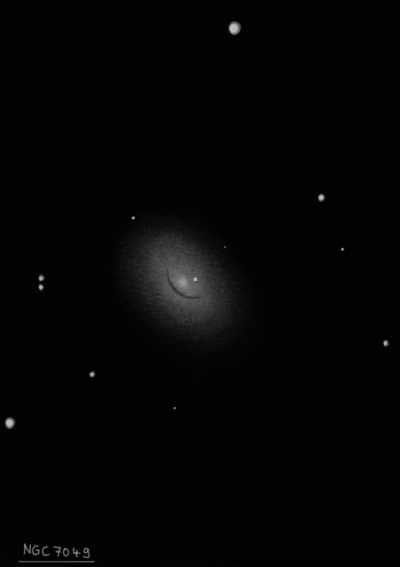
Brightest in a group a (LGG 444), along with NGC 7041 27' NW. ESO 235-85 lies 7.5' WNW. NGC 7049A = ESO 235-84 + NGC 7041B lies 14' NW. Also one of the brightest members of the Pavo-Indus Cloud along with NGCs 7041, 7083, 7144, 7205.
ESO 235-085 is fairly bright, fairly small, elongated 3:2 NW-SE, 24"x18", very high surface brightness. A mag 15.6 star is 35" N of center.
James Dunlop discovered NGC 7049 = D 406 = h3860 on 4 Aug 1826 and recorded "a small round nebula, about 12 or 15 arcseconds diameter, very bright immediately at the centre, resembling a small star surrounded by an atmosphere. This is N.f. a star of the 6th magnitude." His position is 4' ENE of center. John Herschel observed the galaxy twice, improved the position, and logged on 30 Sep 1834, "vB, pS, pmE, psvmbM, 25" long, 15" broad." Two nights later he noted "B, R, pgmbM, 1'."
600/800mm - 30" (10/14/15 - OzSky): at 394x; extremely bright, large, oval 4:3 SW-NE, at least 2.0'x1.5', high surface brightness, very sharply concentrated with a blazing core that is mottled and increases to a stellar nucleus. A faint star is embedded just west of the core (not visible on overexposed images).
Notes by Steve Gottlieb
NGC 7090
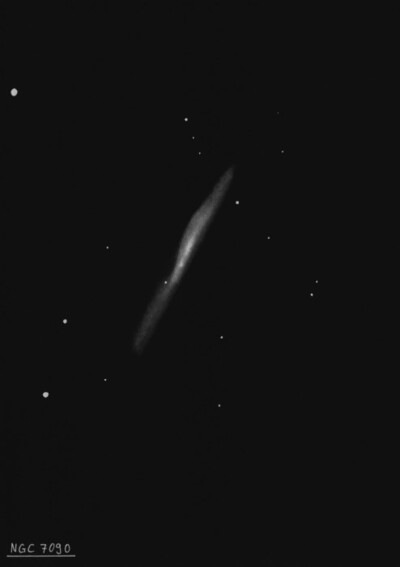
John Herschel discovered NGC 7090 = h3872 on 4 Oct 1834 and recorded "pB; L; vmE in pos 127.1°; first gradually, the pretty suddenly lbM to a v feeble nucleus; 4' l, 40" br; has a * 11m preceding. In the foreground of the Pavo-Indus Cloud which includes NGCs 7213, 7205, 7049, 7083 and 7144.
200/250mm - 11" (8/8/04 - Haleakala Crater): moderately bright, fairly large, edge-on 5:1 NW-SE, 4.0'x0.8', broad concentration but with no distinct core. Irregular surface brightness with a mottled appearance at 127x. Appears to fade suddenly in a couple of spots (possibly due to dust) including just SE of a mag 14 star that is superimposed on the SE side. Viewed at an elevation of 13°.
600/800mm - 25" (10/21/17 - OzSky): at 244x; bright, very large irregular edge-on ~7:1 NW-SE, ~5'x0.7'. Overall the galaxy has a striking patchy appearance with an irregular surface brightness (somewhat similar to NGC 253). It contains a very elongated, sightly brighter core region with a mag 14 star superimposed just southeast of the core. The entire northern flank of the galaxy is very uneven or patchy due to dust patches or a dust lane. The surface brightness of the galaxy drops significantly as it extends southeast of the star for ~2'. The northwest wing beyond the core dims more gradually to the tip. A mag 9 star (HD 205124) is located 12' W, a mag 9.3 star (HD 205308) is 8' N, and a 1.2' pair of mag 9.5/10 star is ~7' NE.
Notes by Steve Gottlieb
NGC 7041
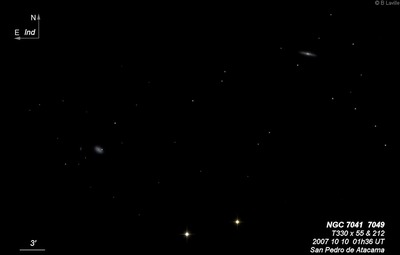
ESO 235-083 is fairly faint, small, slightly elongated NNW-SSE, 24"x18", broad weak concentration. A mag 15.6 star is 35" N of center. NGC 7041A is moderately bright and large, oval 4:3 SSW-NNE, ~0.8'x0.6', slightly brighter nucleus.
John Herschel discovered NGC 7041 = h3859 on 7 Jul 1834 and recorded "B; pmE; psmbM; 40" l; has a * 11m sf." His position (measured on 2 sweeps) is accurate.
600/800mm - 30" (10/14/15 - OzSky): at 394x; extremely bright, very large, elongated nearly 3:1 E-W, ~2.8'x1.0', high surface brightness, very sharply concentrated with an intensely bright, very elongated core. A mag 10.7 star is 2' SSE and a mag 10.4 star is 6' WNW. NGC 7049 lies 27' SE. These two galaxies are the brightest in a group including ESO 235-083 14' ENE and NGC 7014A/7041B 14' ESE.
Notes by Steve Gottlieb
NGC 7192
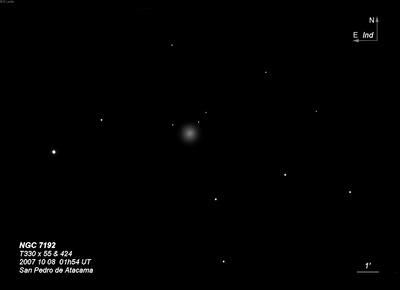
John Herschel discovered NGC 7192 = h3914 on 22 Jun 1835 and recorded "pB; S; R; gpmbM; 20"." His position (measured on two sweeps) is accurate.
400/500mm - 18" (7/6/02 - Magellan Observatory, Australia): fairly bright, round, 1.5' diameter, well concentrated with a very small bright core. A mag 10.5 star lies 5.7' E. Brightest in a group with 5 members including NGC 7179, NGC 7191, NGC 7199 and NGC 7219.
Notes by Steve Gottlieb
NGC 7179
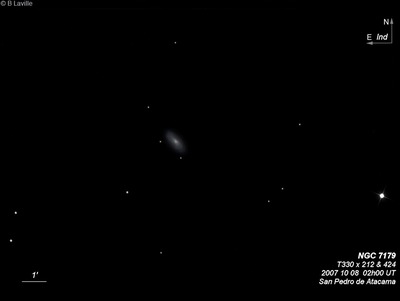
John Herschel discovered NGC 7179 = h3907 on 22 Jun 1835 and recorded "F; R or lE; vgbM; 40"." His mean position (2 sweeps) is very accurate.
400/500mm - 18" (7/6/02 - Magellan Observatory, Australia): first in a group of 5 galaxies with brightest member NGC 7192. At 228x, NGC 7179 appeared moderately bright, fairly large, elongated 5:2 SW-NE, 1.8'x0.7', brighter core. I had the impression this was a barred spiral. A mag 14 star is just south of the NE end. Located 21' NW of NGC 7192.
Notes by Steve Gottlieb
